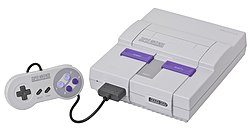
Back Super Nintendo Entertainment System AN سوبر نينتندو إنترتينمنت سيستم Arabic سوبر نينتندو انترتنمنت سيستم ARZ Super Nintendo AST Super Nintendo Entertainment System Breton Super Nintendo Catalan سوپەر نینتێندۆ CKB Super Nintendo Entertainment System Czech Super Nintendo Entertainment System Danish Super Nintendo Entertainment System German
 | |
  | |
| Also known as | |
|---|---|
| Developer | Nintendo R&D2 |
| Manufacturer | Nintendo |
| Type | Home video game console |
| Generation | Fourth |
| Release date | |
| Lifespan | 1990–2005[7] |
| Introductory price |
|
| Discontinued | |
| Units sold |
|
| Media | ROM cartridge |
| CPU | Ricoh 5A22 @ 3.58 MHz |
| Sound | Nintendo S-SMP |
| Online services |
|
| Best-selling game |
|
| Predecessor | NES |
| Successor | Nintendo 64 |
The Super Nintendo Entertainment System, commonly shortened to Super Nintendo,[b] Super NES or SNES,[c] is a 16-bit home video game console developed by Nintendo that was released in 1990 in Japan and South Korea,[16] 1991 in North America, 1992 in Europe and Oceania and 1993 in South America. In Japan, it is called the Super Famicom (SFC).[d] In South Korea, it is called the Super Comboy[e] and was distributed by Hyundai Electronics.[17] The system was released in Brazil on August 30, 1993,[16][18] by Playtronic. Although each version is essentially the same, several forms of regional lockout prevent cartridges for one version from being used in other versions.
The Super NES is Nintendo's second programmable home console, following the Nintendo Entertainment System (NES). The console introduced advanced graphics and sound capabilities compared with other systems at the time, like the Sega Genesis. It was designed to accommodate the ongoing development of a variety of enhancement chips integrated into game cartridges to be more competitive into the next generation.
The Super NES received largely positive reviews and was a global success, becoming the best selling console of the 16-bit era after launching relatively late and facing intense competition from Sega's Genesis console in North America and Europe. Overlapping the NES's 61.9 million unit sales, the Super NES remained popular well into the 32-bit era, with 49.1 million units sold worldwide by the time it was discontinued in 2003. It continues to be popular among collectors and retro gamers, with new homebrew games and Nintendo's emulated rereleases, such as on the Virtual Console, the Super NES Classic Edition, Nintendo Switch Online; as well as several non-console emulators which operate on a desktop computer or mobile device, such as Snes9x.
Cite error: There are <ref group=lower-alpha> tags or {{efn}} templates on this page, but the references will not show without a {{reflist|group=lower-alpha}} template or {{notelist}} template (see the help page).
- ^ "Retro Diary: 08 November – 05 December". Retro Gamer. No. 122. December 13, 2013. p. 11.
- ^ a b "Super Nintendo Entertainment System (Platform)". Giant Bomb. Archived from the original on March 30, 2019. Retrieved August 16, 2019.
- ^ "History | Corporate". Nintendo. Archived from the original on September 4, 2012. Retrieved February 24, 2013.
- ^ C. Portilla (November 21, 2015). "Los juegos más recordados a 25 años del lanzamiento de la Super Nintendo". La Tercera. Archived from the original on January 21, 2022. Retrieved January 20, 2022.
- ^ "Nintendo chega hoje ao mercado". O Estado de S. Paulo. August 30, 1993. Archived from the original on February 27, 2014. Retrieved May 6, 2018.
- ^ "Соглашение Steepler и Nintendo". November 1994. Archived from the original on April 27, 2019. Retrieved December 7, 2022.
- ^ a b "Consolidated Sales Transition by Region" (PDF). Nintendo. Archived (PDF) from the original on June 13, 2018. Retrieved October 25, 2017.
- ^ Reisinger, Don (January 21, 2009). "Does the Xbox 360's 'Lack of Longevity' Matter?". CNET. Archived from the original on December 8, 2015. Retrieved October 23, 2015.
- ^ Wolf, Mark J. P. (November 21, 2018). The Routledge Companion to Media Technology and Obsolescence. Routledge. ISBN 978-1-315-44266-2. Archived from the original on August 1, 2020. Retrieved August 16, 2019.
- ^ Cite error: The named reference
Endwas invoked but never defined (see the help page). - ^ "The Nintendo Years: 1990". Edge. June 25, 2007. p. 2. Archived from the original on August 20, 2012. Retrieved June 27, 2007.
- ^ "Platinum Titles". Capcom. Archived from the original on June 5, 2011. Retrieved August 21, 2010.
- ^ Nintendo of Europe. "Super Nintendo". nintendo.co.uk. Archived from the original on August 20, 2020. Retrieved March 3, 2019.
- ^ "SNES Development Manual" (PDF). Archived (PDF) from the original on February 6, 2016. Retrieved February 5, 2016.
- ^ "Do you say NES or N-E-S?". Nintendo NSider Forums. Archived from the original on May 5, 2008. Retrieved September 23, 2007. Additional archived pages: 2 3 4 5 8 9 ; "Pronouncing NES & SNES". GameSpot forums. Archived from the original on February 14, 2012. Retrieved May 16, 2007.
- ^ a b Brian Byrne, Brian (2017). History of the Super Nintendo (SNES): Ultimate Guide to the SNES Games & Hardware. Console Gamer Magazine. p. 4. ISBN 978-1-5498-9956-0.
- ^ Brian Byrne, Brian (2017). History of the Super Nintendo (SNES): Ultimate Guide to the SNES Games & Hardware. Console Gamer Magazine. p. 5. ISBN 978-1-5498-9956-0.
- ^ Coelho, Victor (November 24, 2014). "Super Nintendo completa 24 anos" [Super Nintendo turned 24 years old]. Exame (in Portuguese). Archived from the original on November 6, 2018. Retrieved June 3, 2018.
© MMXXIII Rich X Search. We shall prevail. All rights reserved. Rich X Search